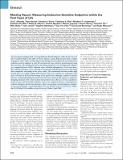| dc.contributor.author | Arbuckle, Tye E. | |
| dc.contributor.author | Swan, Shanna H. | |
| dc.contributor.author | Mao, Catherine S. | |
| dc.contributor.author | Longnecker, Matthew P. | |
| dc.contributor.author | Main, Katharina M. | |
| dc.contributor.author | Whyatt, Robin M. | |
| dc.contributor.author | Mendola, Pauline | |
| dc.contributor.author | Rovet, Joanne | |
| dc.contributor.author | Till, Christine | |
| dc.contributor.author | Wade, Mike | |
| dc.contributor.author | Jarrell, John | |
| dc.contributor.author | Matthews, Stephen | |
| dc.contributor.author | Van Vliet, Guy | |
| dc.contributor.author | Bornehag, Carl-Gustaf | |
| dc.contributor.author | Mieusset, Roger | |
| dc.contributor.author | Hauser, Russ B. | |
| dc.contributor.author | Legrand, Melissa | |
| dc.date.accessioned | 2011-12-24T05:31:49Z | |
| dc.date.issued | 2008 | |
| dc.identifier.citation | Arbuckle, Tye E., Russ Hauser, Shanna H. Swan, Catherine S. Mao, Matthew P. Longnecker, Katharina M. Main, Robin M. Whyatt, et al. 2008. Meeting report: Measuring endocrine-sensitive endpoints within the first years of life. Environmental Health Perspectives 116(7): 948-951. | en_US |
| dc.identifier.issn | 0091-6765 | en_US |
| dc.identifier.uri | http://nrs.harvard.edu/urn-3:HUL.InstRepos:5978682 | |
| dc.description.abstract | An international workshop titled “Assessing Endocrine-Related Endpoints within the First Years of Life” was held 30 April–1 May 2007, in Ottawa, Ontario, Canada. Representatives from a number of pregnancy cohort studies in North America and Europe presented options for measuring various endocrine-sensitive endpoints in early life and discussed issues related to performing and using those measures. The workshop focused on measuring reproductive tract developmental endpoints [e.g., anogenital distance (AGD)], endocrine status, and infant anthropometry. To the extent possible, workshop participants strove to develop or recommend standardized measurements that would allow comparisons and pooling of data across studies. The recommended outcomes include thigh fat fold, breast size, vaginal cytology, AGD, location of the testis, testicular size, and growth of the penis, with most of the discussion focusing on the genital exam. Although a number of outcome measures recommended during the genital exam have been associated with exposure to endocrine-disrupting chemicals, little is known about how predictive these effects are of later reproductive health or other chronic health conditions. | en_US |
| dc.language.iso | en_US | en_US |
| dc.publisher | National Institute of Environmental Health Sciences | en_US |
| dc.relation.isversionof | doi:10.1289/ehp.11226 | en_US |
| dc.relation.hasversion | http://www.ncbi.nlm.nih.gov/pmc/articles/PMC2453165/pdf/ | en_US |
| dash.license | LAA | |
| dc.subject | anogenital distance | en_US |
| dc.subject | anthropometry | en_US |
| dc.subject | endocrine disruptors | en_US |
| dc.subject | genital exam | en_US |
| dc.subject | hormones | en_US |
| dc.subject | infants | en_US |
| dc.subject | measurement | en_US |
| dc.subject | neurodevelopment | en_US |
| dc.subject | reproductive tract development | en_US |
| dc.subject | sexual dimorphism | en_US |
| dc.title | Meeting Report: Measuring Endocrine-Sensitive Endpoints within the First Years of Life | en_US |
| dc.type | Journal Article | en_US |
| dc.description.version | Version of Record | en_US |
| dc.relation.journal | Environmental Health Perspectives | en_US |
| dash.depositing.author | Hauser, Russ B. | |
| dc.date.available | 2011-12-24T05:31:49Z | |
| dash.affiliation.other | HMS^Obstetrics Gynecology and Repro. Bio. - MGH | en_US |
| dash.affiliation.other | SPH^Environmental+Occupational Medicine+Epi | en_US |
| dc.identifier.doi | 10.1289/ehp.11226 | * |
| dash.authorsordered | false | |
| dash.contributor.affiliated | Hauser, Russ | |


